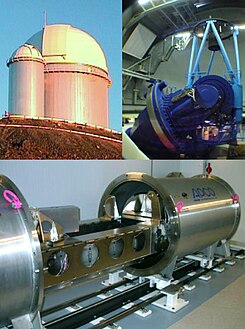High Accuracy Radial Velocity Planet Searcher

The High Accuracy Radial Velocity Planet Searcher (HARPS) is a high-precision echelle planet-finding spectrograph installed in 2002 on the ESO's 3.6m telescope at La Silla Observatory in Chile. The first light was achieved in February 2003. HARPS has discovered over 130 exoplanets to date, with the first one in 2004, making it the most successful planet finder behind the Kepler space telescope. It is a second-generation radial-velocity spectrograph, based on experience with the ELODIE and CORALIE instruments.[1]
Characteristics
[edit]The HARPS can attain a precision of 0.97 m/s (3.5 km/h),[2] making it one of only two instruments worldwide with such accuracy.[citation needed] This is due to a design in which the target star and a reference spectrum from a thorium lamp are observed simultaneously using two identical optic fibre feeds, and to careful attention to mechanical stability: the instrument sits in a vacuum vessel which is temperature-controlled to within 0.01 kelvins.[3] The precision and sensitivity of the instrument is such that it incidentally produced the best available measurement of the thorium spectrum.[citation needed] Planet-detection is in some cases limited by the seismic pulsations of the star observed rather than by limitations of the instrument.[4]
The principal investigator on the HARPS is Michel Mayor who, along with Didier Queloz and Stéphane Udry, have used the instrument to characterize the Gliese 581 planetary system, home to one of the smallest known exoplanets orbiting a normal star, and two super-Earths whose orbits lie in the star's habitable zone.[5]
It was initially used for a survey of one-thousand stars.[citation needed]
Since October 2012 the HARPS spectrograph has the precision to detect a new category of planets: habitable super-Earths. This sensitivity was expected from simulations of stellar intrinsic signals, and actual observations of planetary systems. Currently, the HARPS can detect habitable super-Earth only around low-mass stars as these are more affected by gravitational tug from planets and have habitable zones close to the host star.[6]
Discoveries
[edit]This is an incomplete list of exoplanets discovered by the HARPS. The list is sorted by the date of the discovery's announcement. As of December 2017, the list contains 134 exoplanets.
|
|
|
Gallery
[edit]-
HELIOS instrument installed to feed sunlight via fibre optics to the HARPS[7]
-
A decade of discoveries from HARPS[8]
-
HARPS spectrograph
-
HARPS spectrograph detail
-
Animation of HD 10180 with its seven planets
See also
[edit]
Similar instruments:
- HARPS-N is a copy of this instrument installed in the northern hemisphere in 2012.
- HARPS3 is an updated design of this instrument that will be installed on an upgraded and roboticised Isaac Newton Telescope, in 2024.
- Fiber-optic Improved Next-generation Doppler Search for Exo-Earths, operating at Lick observatory since 2009
- Anglo-Australian Planet Search or AAPS is another southern hemisphere planet search program.
- ESPRESSO is a new-generation spectrograph for ESO's VLT.
- Automated Planet Finder, at the Lick observatory, commissioned in 2013.
- CAFE (Calar Alto Fibre-fed Echelle spectrograph) installed on the Calar Alto Observatory's 2.2-metre telescope in 2014, and the CARMENES mounted on the 3.5-metre telescope in 2016.
- EXPRES is a third generation radial velocity spectrograph that is planned to be installed on the Lowell Discovery Telescope.
Space based detectors :
- CoRoT, spacecraft operating since 2007
- Kepler space telescope, operational until 2018
- Terrestrial Planet Finder, cancelled
- Space Interferometry Mission, construction halted in 2010
- Darwin, early studies for a multi-satellite mission
Notes
[edit]- ^ has a shorter period.
- ^ a b This is an M sin i brown dwarf.
- ^ This is a brown dwarf.
References
[edit]- ^ Mayor, M.; Pepe, F.; Queloz, D.; Bouchy, F.; Rupprecht, G.; Lo Curto, G.; Avila, G.; Benz, W.; Bertaux, J.-L.; et al. (2003). "Setting New Standards With HARPS" (PDF). ESO Messenger. 114: 20. Bibcode:2003Msngr.114...20M.
- ^ "32 planets discovered outside solar system - CNN.com". CNN. 19 October 2009. Retrieved 4 May 2010.
- ^ Lovis, Christophe; Pepe, Francesco; Bouchy, François; Lo Curto, Gaspare; Mayor, Michel; Pasquini, Luca; Queloz, Didier; Rupprecht, Gero; Udry, Stéphane; Zucker, Shay (2006). "The exoplanet hunter HARPS: Unequalled accuracy and perspectives toward 1 cm s−1precision" (PDF). In McLean, Ian S.; Iye, Masanori (eds.). Ground-based and Airborne Instrumentation for Astronomy. Proceedings of SPIE. Vol. 6269. pp. 62690P. Bibcode:2006SPIE.6269E..0PL. doi:10.1117/12.669991. S2CID 120961535. Retrieved 14 September 2011.
- ^ Carrier; Eggenberger, P; Leyder, J-C (2008). "Asteroseismology of solar-type stars: particular physical effects" (PDF). Journal of Physics: Conference Series. 118 (1): 012047. Bibcode:2008JPhCS.118a2047C. doi:10.1088/1742-6596/118/1/012047.
- ^ Mayor, Michel; Bonfils, Xavier; Forveille, Thierry; et al. (2009). "The HARPS search for southern extra-solar planets, XVIII. An Earth-mass planet in the GJ 581 planetary system" (PDF). Astronomy and Astrophysics. 507 (1): 487–494. arXiv:0906.2780. Bibcode:2009A&A...507..487M. doi:10.1051/0004-6361/200912172. S2CID 2983930. Archived from the original (PDF) on 21 May 2009.
- ^ Anglada-Escudé, Guillem; Amado, Pedro J.; Barnes, John; et al. (2016). "A terrestrial planet candidate in a temperate orbit around Proxima Centauri" (PDF). Nature. 536 (7617): 437–440. arXiv:1609.03449. Bibcode:2016Natur.536..437A. doi:10.1038/nature19106. PMID 27558064. S2CID 4451513.
- ^ "HARPS Sees Sunshine for the First Time". www.eso.org. Retrieved 18 May 2018.
- ^ "A decade of discoveries from HARPS". www.eso.org.
- ^ "A Sparkling Ribbon of Stars — The Southern Milky Way over La Silla". ESO Picture of the Week. Retrieved 11 April 2013.
External links
[edit] Media related to HARPS spectrograph at Wikimedia Commons
Media related to HARPS spectrograph at Wikimedia Commons- "HARPS Home Page". ESO. Retrieved 25 April 2009.
- "The Exoplanet Hunter HARPS: unequalled accuracy and perspectives towards 1 cm/s precision" (PDF). ESO. (Contains list of discoveries from 2005 survey.)
- "New Planet-Hunting Technology Accelerates Discovery of Exo-Planets & Solar Systems". Daily Galaxy. 17 June 2008. Archived from the original on 7 October 2008. Retrieved 19 October 2008.
- "Astronomers discover 4 new planets". NASA. 27 March 2007. Archived from the original on 22 April 2007.

![HELIOS instrument installed to feed sunlight via fibre optics to the HARPS[7]](http://upload.wikimedia.org/wikipedia/commons/thumb/0/00/The_HELIOS_instrument_at_the_ESO_3.6-metre_telescope_in_Chile.jpg/120px-The_HELIOS_instrument_at_the_ESO_3.6-metre_telescope_in_Chile.jpg)
![A decade of discoveries from HARPS[8]](http://upload.wikimedia.org/wikipedia/commons/thumb/a/a7/A_decade_of_discoveries_from_HARPS.jpg/120px-A_decade_of_discoveries_from_HARPS.jpg)




